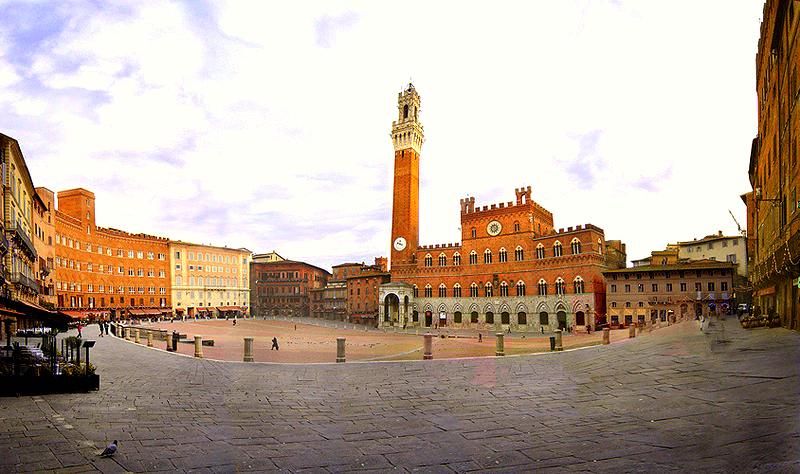Pictures by John Heseltine
The site of Siena was originally an Etruscan settlement that later became the Roman city of Sena Julia, founded by Senius, son of Remus (one of the two legendaryfounders of Rome). Hence the famous symbol of the suckling she-wolf became the civic badge, seen wherever the republic held sway.
The Middle Ages saw Siena’s heyday, when it became one of Europe’s wealthiest cities, with a thriving textile industry. Much to the envy of Florence, it also boasted the first international banks in the world, raking in money from the whole of Christendom on behalf of the papacy.
During this time, Sienese painters (including Duccio di Buoninsegna, Simone Martini, Giovanni Pisano and the Lorenzetti brothers) were shaping the history of Italian and European art, with their early experimentation in techniques of perspective, their refined Gothic stylisation and their minute attention to detail. Appropriately, the city’s reddish-brown soil, rich in ferric oxide deposits, gave its name to the pigment ‘burnt Sienna’, so beloved by the great masterpainters.
Their works can be seen today in several of the city’s galleries. The ninth-century Ospedale di Santa Maria della Scala, a hospital for 800 years, now counts among Italy’s top galleries with its huge old wards smothered in frescoes.
Siena’s main gallery is the Pinacoteca Nazionale. Here, many works depict the surrounding countryside with its softly-hued hills and vine-yards, apricot-and butters cotch-coloured farmhouses and neat rows of cypresses, but ‘The Adoration of the Magi’ by Bartolo di Fredi shows a particularly realistic glimpse of the city at the height of its 14th-century glory.
The Duomo

Siena’s greatest treasure is probably its striking Duomo (1136-1382), considered among the masterpieces of Italian Gothic architecture. This lavish confection of black-and-white striped marble, and its matching campanile, is set majestically atop Siena’s highest hill.
The exuberant façade is a blend of pink-and-white marble with a striking and, some say, tasteless mixture of medieval statuary and 19th-century mosaic. The equally lavish interior was described by Ruskin as ‘overstriped, over-crocketed, over-gabled... apiece of faithless vanity’.
Not only does it echo the two-tone marble banded-marble motif of the exterior, but it contains Italy’s finest carved pulpit depicting scenes from ‘The Life of Christ’, created by Nicola Pisano, dazzling stained-glass windows by Duccio, and an astonishing inlaid marble pavement illustrating the Advent of Christianity and other stories from the Bible.

The best bird’s-eye view over Siena is from the slender Torre del Mangia, towering high above Siena’s main square – the Piazza del Campo. It was built in 1348 to mark the end of the feudal era as a symbol of the freedom of the city-state, and named after its firstbell-ringer, a spendthrift renowned for his laziness, nick-named Mangiaguadagni (literally ‘eat the profits’).
At 102 metres, it was intended to surpass every existing tower in Italy. The 505-step climb to the top is richly rewarded by sweeping views over Siena’s patchwork of roofs, the striking main square and the picturesque surrounding countryside.
No matter which way you turn in the labyrinth of medieval streets and alleys, they all seem to lead to the Campo. This vast red-bricked, seashell-shaped open space is considered one of the most dazzling designs of Italian town planning.

Tilted to accommodate the natural incline of the hillside, it is divided by long white marble spokes into nine segments, in honour of the ‘Council of Nine’, the city rulers of the time. Even the magnificent semicircle of elegant rose-coloured palazzi surrounding the square were constructed according to strict building regulations, to maintain the dignity of the city’s greatest square.
The most impressive palace on the square is undoubtedly the majestic Palazzo Pubblico, seat of Sienese government since the Middle Ages. Within the palace, the Museo Civico contains some of the city’s finest frescoes, notably Ambrogio Lorenzetti’s dazzling ‘Allegories of Good and Bad Government’, considered to be among the most important Medieval secular paintings in the world.

For centuries the Campo has been the hub of Sienese life: fruit, vegetables and livestock were sold here, grain was handed out to the poor, heretics were burnt, and illustrious visitors were wined and dined. Today, it is a popular meeting place ringed by tiny shops offering visitors a chance to try some of the local specialities – Sienese pecorino cheese, delicious washed down with a glass of Tuscan wine; panforte, a dark, dense cake of candied fruit, nuts, cinnamon and cloves; or ricciarelli sweets, made from ground almonds, orange peel and honey.
After dark, the square takes on an almost magical atmosphere, alive with al fresco diners in the restaurants and cafés surrounding the fan-shaped square. But the Campo is probably most celebrated as the venue of Tuscany’s best-known festival - the Palio, a fiercely contested bareback horse-race between the various wards of the city, which takes place annually on 2nd July and 16th August.










